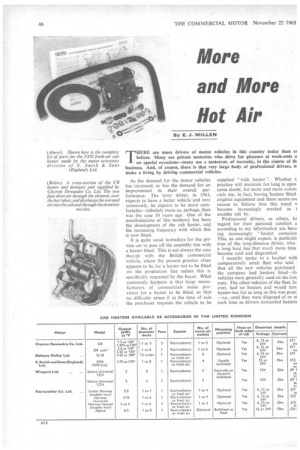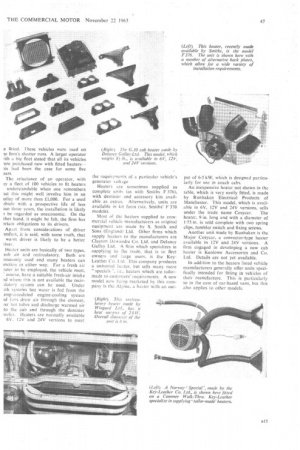More and More Hot Air
Page 48

Page 49

If you've noticed an error in this article please click here to report it so we can fix it.
By E. J. MILLEN
THERE are more drivers of motor vehicles in this country today than el before. Many are private motorists who drive for pleasure at week-ends a on special occasions—many use a motorcar, of necessity, in the course of th business. And, of course, there is that very large body of professional drivers, w make a living by driving commercial vehicles.
As the demand for the motor vehicles has increased, so has the demand for an improvement in their overall performance. The lorry driver, in 1963, expects to have a better vehicle and very commonly, he expects to be more comfortable—infinitely more so, perhaps, than was the case 10 years ago. One of the manifestations of this tendency has been the development of the cab heater, and the increasing frequency with which this is now fitted.
It is quite usual nowadays for the private car to pass off the assembly line with a heater fitted. This is not always the case though with the British commercial vehicle, where the present practice often appears to be for a heater not to be fitted on the production line unless this is specifically requested by the buyer. What commonly happens is that large manufacturers of commercials make provision for a heater to be fitted, so that no difficulty arises if at the time of sale the purchaser requests the vehicle to be
supplied " with heater ". Whether t practice will maintain for long is open some doubt, for more and more comm cials are, in fact, having heaters fitted original equipment and there seems evt reason to believe that this trend v become increasingly marked as I months roll by.
Professional drivers, as others, regard for their personal comfort a according to my information are beco ing increasingly "heater consciow This, as one might expect, is particula true of the Long-distance driver, who a long haul has that much more time become cold and disgruntled.
I recently spoke to a haulier with comparatively small fleet who told that all the new vehicles purchased the company had heaters fitted—th vehicles were generally used on the lom runs. The other vehicles of the fleet, hc ever, had no heaters and would rem heater-less for as long as this was possi —i.e., until they were disposed of or ui such time as drivers demanded heaters
e fitted. These vehicles were used on le firm's shorter runs. A larger operator ,ith a big fleet stated that all its vehicles .cre purchased new with fitted heaters—
is been the case for some five ears.
The reluctance of an operator, with iy a fleet of 100 vehicles to fit heaters . understandable when one remembers at this might well involve him in an utlay of more than /1,000. For a used ehicle with a prospective life of less tan three years, the installation is likely ) be regarded as uneconomic. On the ther hand, it might be felt, the firm has 2:rtain obligations to its drivers.
Apart from considerations of driver amfort, it is said, with some truth, that warm driver is likely to be a better river.
Heater units are basically of two types, .esh air and recirculatory. Both are )mmottly used and many heaters can metion in either way. For a fresh air mter to be employed, the vehicle must, course, have a suitable fresh-air intake Id where this is not available the recirilatory system can be used. Under Dth systems hot water is fed from the imp-circulated engine-cooling system id fans draw air through the element, ier hot tubes and discharge warmed air to the cab and through the demister )ziles. Heaters are normally available 6V. 12V and 24V versions to meet the requirements of a particular vehicle's generator vo I tage Heaters are sometimes supplied as complete units (as with Smiths F376), with demister and accessory kits available as extras. Alternatively, units are available in k it form (viz. Smiths' F 370 models).
Most of the heaters supplied to commercial vehicle manufacturers as original equipment are made by S. Smith and Sons (England) Ltd. Other firms which supply heaters to the manufacturers are Clayton Dewandre Co. Ltd. and Delaney Gallay Ltd. A firm which specializes in supplying to the trade, that is to fleet owners and large users, is the KeyLeather Co. lid. This company produces a universal heater, but sells many more
" specials i.e.. heaters which are tailormade to customers' requirements. A new model now being marketed by this cornpdny is the Alpine. a heater with an out
put of 6-5 kW, which is designed particularly for use in coach cabs.
An inexpensive heater not shown in the table, which is very easily fitted, is made by Run baken Electrical Products of Manchester. This model, which is available in 6V, 12V and 24V versions, setts under the trade name Cosycar. The heater, 9 in. long and with a diameter of 1-75 in. is sold complete with two spring clips, tumbler switch and fixing screws.
Another unit made by Runbaken is the Major Cosycar, a convector-type heater available in 12V and 24V versions. A firm engaged in developing a new cab heater is Kenlowe Accessories and Co. Ltd. Details are not yet available.
In addition to the heaters listed vehicle manufacturers generally offer units specifically intended for fitting in vehicles of their manufacture. This is particularly so in the case of ear-based vans, but this also applies to other models.




































































































